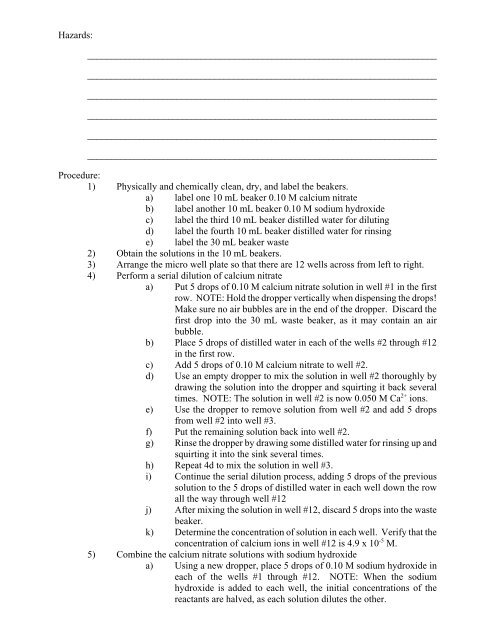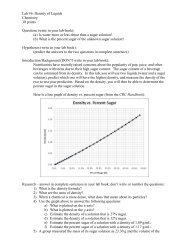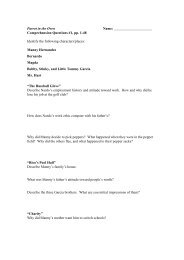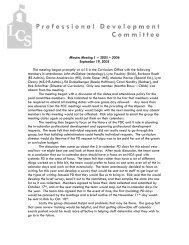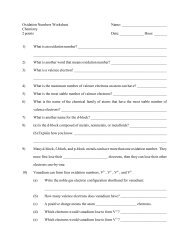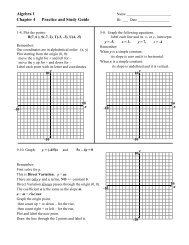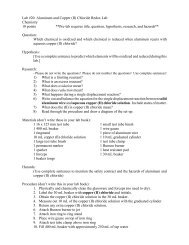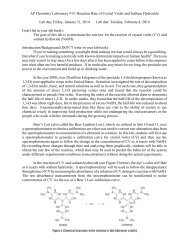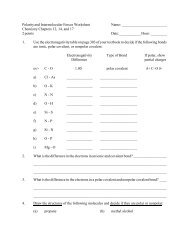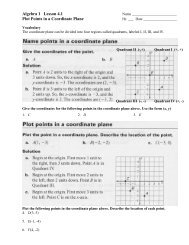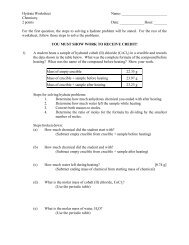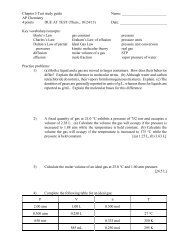Lab #20: Determination of the Ksp of a Chemical Name: Reaction ...
Lab #20: Determination of the Ksp of a Chemical Name: Reaction ...
Lab #20: Determination of the Ksp of a Chemical Name: Reaction ...
Create successful ePaper yourself
Turn your PDF publications into a flip-book with our unique Google optimized e-Paper software.
Hazards:____________________________________________________________________________________________________________________________________________________________________________________________________________________________________________________________________________________________________________________________________________________________________________________________________________________________________________________________Procedure:1) Physically and chemically clean, dry, and label <strong>the</strong> beakers.a) label one 10 mL beaker 0.10 M calcium nitrateb) label ano<strong>the</strong>r 10 mL beaker 0.10 M sodium hydroxidec) label <strong>the</strong> third 10 mL beaker distilled water for dilutingd) label <strong>the</strong> fourth 10 mL beaker distilled water for rinsinge) label <strong>the</strong> 30 mL beaker waste2) Obtain <strong>the</strong> solutions in <strong>the</strong> 10 mL beakers.3) Arrange <strong>the</strong> micro well plate so that <strong>the</strong>re are 12 wells across from left to right.4) Perform a serial dilution <strong>of</strong> calcium nitratea) Put 5 drops <strong>of</strong> 0.10 M calcium nitrate solution in well #1 in <strong>the</strong> firstrow. NOTE: Hold <strong>the</strong> dropper vertically when dispensing <strong>the</strong> drops!Make sure no air bubbles are in <strong>the</strong> end <strong>of</strong> <strong>the</strong> dropper. Discard <strong>the</strong>first drop into <strong>the</strong> 30 mL waste beaker, as it may contain an airbubble.b) Place 5 drops <strong>of</strong> distilled water in each <strong>of</strong> <strong>the</strong> wells #2 through #12in <strong>the</strong> first row.c) Add 5 drops <strong>of</strong> 0.10 M calcium nitrate to well #2.d) Use an empty dropper to mix <strong>the</strong> solution in well #2 thoroughly bydrawing <strong>the</strong> solution into <strong>the</strong> dropper and squirting it back severaltimes. NOTE: The solution in well #2 is now 0.050 M Ca 2+ ions.e) Use <strong>the</strong> dropper to remove solution from well #2 and add 5 dropsfrom well #2 into well #3.f) Put <strong>the</strong> remaining solution back into well #2.g) Rinse <strong>the</strong> dropper by drawing some distilled water for rinsing up andsquirting it into <strong>the</strong> sink several times.h) Repeat 4d to mix <strong>the</strong> solution in well #3.i) Continue <strong>the</strong> serial dilution process, adding 5 drops <strong>of</strong> <strong>the</strong> previoussolution to <strong>the</strong> 5 drops <strong>of</strong> distilled water in each well down <strong>the</strong> rowall <strong>the</strong> way through well #12j) After mixing <strong>the</strong> solution in well #12, discard 5 drops into <strong>the</strong> wastebeaker.k) Determine <strong>the</strong> concentration <strong>of</strong> solution in each well. Verify that <strong>the</strong>concentration <strong>of</strong> calcium ions in well #12 is 4.9 x 10 -5 M.5) Combine <strong>the</strong> calcium nitrate solutions with sodium hydroxidea) Using a new dropper, place 5 drops <strong>of</strong> 0.10 M sodium hydroxide ineach <strong>of</strong> <strong>the</strong> wells #1 through #12. NOTE: When <strong>the</strong> sodiumhydroxide is added to each well, <strong>the</strong> initial concentrations <strong>of</strong> <strong>the</strong>reactants are halved, as each solution dilutes <strong>the</strong> o<strong>the</strong>r.


